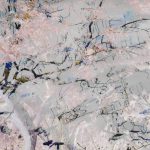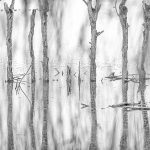In Kruger National Park, hyenas often locate their dens in the culverts at the side of the road. So we weren’t surprised to come upon a hyena family, with several romping pups, at the end of a day’s drive.


We stopped to watch them and, even though the light was already poor, took some photos. One of the pups was slightly older than the others. He stood out because of his white mane. He was slightly more sedate than the younger pups but still adventurous.

Eventually, the younger pups went back into the den in the culvert. The older pup went over to where his mother lay curled up on the ground and started licking her. She simply lay there, visibly enjoying his tender grooming. Then he came up on the road and drank water from the puddles that had collected during the afternoon showers.

The next morning, shortly after sunrise, we passed the culvert again. There was no sign of the pups. Then we spotted the mother, standing guard over a crumpled heap of white. The awful realization hit us: this was the body of the pup with the white mane!

The mother was desolate. She wouldn’t let any of the other hyenas near her dead pup. And the rest of the family seemed to be confused and saddened as well. The younger pups stayed hidden in the den. (We later heard from other visitors that they eventually emerged again.)


What had happened? If a predator or a rival hyena clan had killed it, wouldn’t they have taken the body? Had the pup been too incautious on the road and been hit by a careless driver? We’ll never know. The people we spoke to later said that, eventually, the pup’s family ate his remains.

Note: In telling this tale, I’m obviously guilty of interpreting the body language of an animal as though it has human emotions. This is also known as ‘anthropomorphizing’. However, more and more researchers have proven that animals have emotions. And the body language of hyenas is similar to that of dogs. So I don’t think I’m that far off.






Comments
James King